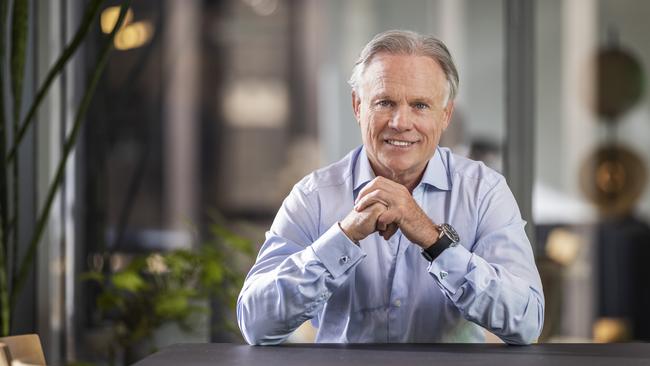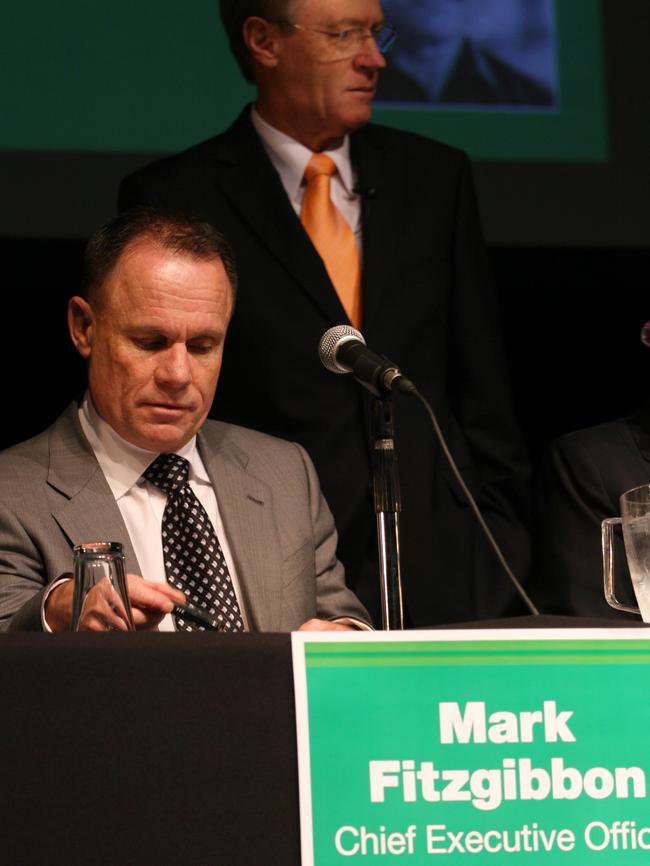How NIB’s Mark Fitzgibbon almost didn’t make it to his own retirement
Had political history gone another way, the puckish insurer may have never got off the ground. But this made it determined not to be an ordinary health fund.

Today’s $3bn private health insurer NIB almost never got a chance to get off the ground.
A plan had been hatched in the early days whereby its bigger rival Medibank was circling the Newcastle-based fund to make the smaller fund its “Jetstar of health”.
That was in 2006. The then Howard government had wanted to privatise the Canberra-owned Medibank. This prompted Medibank to consider bulking up with growth options, and NIB was in its sights.
Then a smallish mutual, NIB had been successful at targeting younger members, and Medibank with its older skew, wanted some of that. It was working with Boston Consulting Group, and it felt the NIB brand would be a good fit as a low-cost, no-frills operator – internally it was dubbed the Jetstar of health insurance in a nod to the Qantas discount offshoot.
However, it would have been complicated and a politically fraught move for the government-owned insurer to make such an acquisition, particularly as Medibank’s sale was becoming a hot-button issue. This all became a footnote in history. Howard delayed the sale of Medibank until after the 2007 election. Howard lost out as Kevin Rudd’s Labor swept control in late 2007 and a Medibank sale was off the agenda entirely.

Three years after eyeing NIB, Medibank, which was still in government hands, bought Wollongong-based AH to drive its no-frills strategy. It still owns AHM today. The Abbott government later took Medibank to a stockmarket float in 2014.
But this isn’t about Medibank, rather the puckish NIB that has defied all the odds as well as the norms to shake up Australia’s staid private health market.
Mark Fitzgibbon, who as chief executive pushed NIB through to a stockmarket listing in November 2007, and through the GFC and the Covid pandemic, almost didn’t make it to his own retirement four weeks from now.
Across the very top of Fitzgibbon’s head is a jagged, fresh 22cm scar. It gives the health fund boss the look of a bar-room brawler.
Fitzgibbon was playing with his grandchildren in a park in his home town of Newcastle a few weeks ago when he slipped under a slide, hit his head and fell back hard. There was blood everywhere and an ambulance was called. Luckily there was a doctor nearby – a gynaecologist – who helped him to compress the deep cut.
“As a patient it was the wrong end and I was the wrong gender,” Fitzgibbon quips. But for the NIB boss it was a closer than comfortable view of the deep stresses on the public health system.
Fitzgibbon starts his story with a comment said far too often. The healthcare workers he dealt with at every step – especially the paramedics – were terrific. But what he saw were professionals, and therefore patients, let down by the design of the system.
It took an hour for the ambulance to arrive, and at the hospital Fitzgibbon was triaged in the emergency ward where he was diagnosed as serious, but not critical. Then he was moved to the hospital’s ramping room.
“There were eight other people on ambulance trolleys at the same time. It was Monday on the long weekend in NSW, each of us had two paramedics, because the paramedics can’t leave us until I’m officially handed over. They sat there for three hours,” Fitzgibbon says.
“By time I got in to see the doctor and had 18 staples put in my head, I said, ‘I’m so embarrassed I got knocked out, but I was OK, but I caused all these issues for you guys’. She said: ‘Well, Mark, we’ll go pick somebody else up now, bring them back and we’ll do the same thing’.”
The NIB chief leans forward to make his point. “It’s such a profound example of the inefficiency in public delivery. It’s not the paramedics’ fault, it’s not the doctor’s fault – it’s just the system design.
“The private system, in terms of funding and delivery, has to survive and has to prosper. I think fortunately there is now a bipartisan recognition that we nee a viable, sustainable, private system.”
Fitzgibbon reaches for the numbers. The public system as we know it today was set up when there were about a dozen taxpayers supporting someone in retirement. Today there’s a little over five. By 2040, as the nation ages, this will be about three taxpayers supporting older people in the healthcare system. Even as health spending is rising in dollar terms, the system can’t cope with the rising demand. This is where private health can make the difference.
“You literally run out of scarce tax resources to fund a public universal healthcare system,” he says.
“Inevitably, you have to shift funding responsibilities towards those who have the means to take greater responsibility for their healthcare.”
Diving in head first
Fitzgibbon, now 64, has been driving NIB at high speed for more than two decades. Through that time he has been charging head first into everything, including taking on the bigger health fund rivals.
His fund led the way through a demutualisation and stockmarket listing, indeed it paved the way for Medibank to hit the market. NIB was the first fund to offer claims payments over a smartphone app.

NIB was an early adopter of the aggregators that turned distribution upside-down. It pushed offshore and became one of the first health funds to move into specialist travel insurance, and it was one of the first to move into white label, its health insurance business now used by partners such as Qantas, ING and Suncorp.
NIB was valued at a little over $440m on listing, and just under $3bn today. Under Fitzgibbon, customers have tripled to more than 1 million. Revenue has surged threefold to $3.3bn. The fund, established by workers at BHP’s former Newcastle steelworks seven decades ago, has pushed offshore and into new health markets like virtual consultations in its Midnight Health acquisition, and another in home care services. More recently it became the first ASX health player to move into NDIS management.
Fitzgibbon was speaking to The Australian from NIB’s Melbourne offices as a simmering dispute between hospitals and private health funds has exploded into open hostilities.
The Brookfield-owned Healthscope, which is facing its own cash crunch, plans to charge private patients from BUPA, the nation’s second-biggest health fund, a $100 fee for overnight hospital stays. Healthscope urged patients to switch funds if they didn’t want to be hit with the fee.
Private Healthcare Australia, the peak body for the health funds, labelled the additional fee as “unethical” and a “new low”. For once, NIB isn’t involved in the fight, but Fitzgibbon certainly has an interest in the outcome.
He says private health has always been marked by robust talks between hospitals and providers. He’s had few heated disputes of his own, but it’s clear the intensity has escalated since the pandemic when private hospitals essentially closed down.
However, the latest skirmish with the fee is “as far as it’s ever gone in my experience”. He suspects the dispute will be resolved soon, but the bigger issue is private hospitals have to learn to adapt to bigger changes in healthcare.
“It’s a silly analogy but if you were charging four bucks a coffee, and you did it really hard during Covid, the cafe was shut down but you were still paying rent, the solution isn’t to come out of Covid and charge $8 for a coffee to restore your margins,” he says.
“There’s a bit of a sentiment in hospitals that we are their only solution, because there are other forces impacting them which we have real no control over.”
The big one here is patient stays getting shorter, especially with advances in surgery – including in and out in a day. There’s more treatment out of hospitals, or avoiding surgery all together.
“Their business models are going to need change, just like we’re trying to change our business model,” Fitzgibbon says.
Handing over
Fitzgibbon prepares to hand over to NIB’s insurance boss, Ed Close at the end of November. However, the market that he steered over the decades hit him on the way out. He was whacked on his last full-year results delivered in August. NIB shares were sold off nearly 20 per cent on the day as a profit squeeze took investors by surprise.
“There’s three rules: don’t be under (market) consensus. Rule two: don’t be under consensus. Rule three: see rules one and two,” Fitzgibbon says of the selldown.
“If you sit back from the result, our revenue is up 10 per cent, our earnings up 5 per cent. Our dividend was up 4 per cent. And for anyone who cared to listen, our margins were always going to come back to more normal target levels. I think everyone just got a bit carried away with the sugar hit through Covid.”
While the future is now over to Close, Fitzgibbon says NIB is well down the path to becoming a fully integrated health management company.
“If you look at the healthcare economy, the $230bn or so we spend, it’s about $35bn in private health insurance,” he says.
“However, we believe we can capture more value from that entire healthcare care market. In order to do that, though, we need to develop the capabilities like Midnight Health acquisition”.
More than two decades as CEO is rare longevity in Australian corporate life. Most bosses notch up a quarter of that on average. But Fitzgibbon says it’s not about time, but performance and energy.
“We’ve never been comfortable with where we’re at,” he says.
“I do think it’s a bit silly how boards expect only a lifespan of maybe five or six years. Is your starting position that you can’t run for much longer than that? And I certainly haven’t found that.
“People were telling Tom Brady he is too old to play in the NFL, years before he actually finished.”
You can keep going “as long as you’ve been constantly invigorated, so long as you still have some balance in your life”.
Still, after 22 years and Fitzgibbon will have a life after NIB. He’s about to get married and there’s the other typical things: “More time with grandkids, get the golf handicap down. But I’m too hyperactive to not do something intellectually.”
And no more head knocks.
johnstone@theaustralian.com.au





To join the conversation, please log in. Don't have an account? Register
Join the conversation, you are commenting as Logout